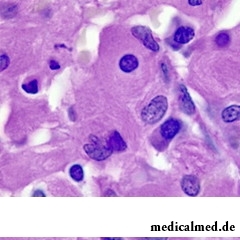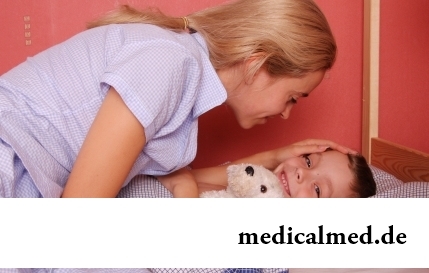





Disease to Gosha
Disease to Gosha – a genetic disease at which fat substances (lipids) collect in cells and on some bodies. The disease  to Gosha is the most widespread of lysosomic diseases of accumulation. It is one of the sphingolipidosis forms (subgroup of lysosomic diseases of accumulation) as it is shown in dysfunctionality of metabolism of sphingolipids.
to Gosha is the most widespread of lysosomic diseases of accumulation. It is one of the sphingolipidosis forms (subgroup of lysosomic diseases of accumulation) as it is shown in dysfunctionality of metabolism of sphingolipids.
Frustration is characterized by fatigue, anemia, low level of thrombocytes in blood, increase in the sizes of a liver and spleen. It is caused by hereditary deficit of enzyme of a glyukotserebrozidaza which works on глюкозилцерамид fatty acids. When enzyme is damaged, глюкозилцерамид collects, in particular, in leukocytes, most often in macrophages (mononuclear leukocytes). Glyukoziltseramid can collect in a spleen, a liver, kidneys, lungs, a brain and marrow.
Increase in a spleen and liver, heavy neurologic complications, hypostasis of lymph nodes and adjacent joints, abdominal distention, brownish skin color, anemia, low level of thrombocytes in blood and scleras can be displays of a disease to Gosha.
The disease is caused by recessive mutation in the gene located on a chromosome 1 and influences both men, and women. About 1 of 100 people in the world is the disease carrier to Gosha. The disease is called in honor of the French doctor Philip to Gosha who originally described it in 1882.
Disease types to Gosha
The disease to Gosha has three general clinical subtypes: type I, type II and type III.
The type I is the most common form of a disease meeting with frequency of 1 on 50000 newborns. Disease symptoms to Gosha of this type can be shown at early age or at mature age and include:
- Increase in a liver and substantially increase in a spleen;
- Weakness of skeletal bones;
- Anemia, thrombocytopenia and leukopenia;
- Damage of kidneys;
- Fatigue.
The type II usually begins to be shown for the first six months since birth and meets frequency about 1 on 100000 newborns. Disease symptoms to Gosha of this type include:
- Increase in a liver and spleen;
- Extensive and progressive injuries of a brain;
- Disturbances of the movement of eyes, spasticity, spasms and rigidity of extremities;
- Weak ability to suck and swallow.
Injured children usually die at the age of 2 years.
The type III (chronic neyropatichesky form) can begin at any time, in the childhood or even at mature age, and meets frequency of 1 on 100000 newborns. The main symptoms include increase in a spleen or liver, a spasm, an incoordination, trouble breathing, skeletal disturbances, disturbances of the movement of eyes, blood diseases, including anemia.
Disease symptoms to Gosha
The general symptoms of a disease to Gosha are:
- The painless hepatomegalia and splenomegaly – the sizes of a spleen can be from 1500 to 3000 ml, unlike the normal size in 50-200 ml. The splenomegaly can reduce appetite, putting pressure upon a stomach, and expansion of a spleen increases risk of a rupture of a spleen;
- Hypersplenism and pancytopenia – bystry and premature destruction of blood cells that leads to anemia, a neutropenia, a leukopenia and thrombocytopenia (with the increased risk of infections and bleedings);
- Cirrhosis;
- Severe pain in joints and bones, often in hip and knee joints;
- Neurologic symptoms;
- Type II: serious spasms, hypertension, mental retardation, apnoea;
- Type III: twitching of muscles, spasms, dementia, apraxia of eye muscles;
- Osteoporosis;
- Yellowish-brown xanthopathy.
Treatment of a disease to Gosha
Treatment of a disease to Gosha of a subtype 1 and 3 can begin with intravenous replacement of enzyme of a recombinant glyukotserebrozidaza that can reduce considerably the sizes of a liver and spleen, skeletal anomalies and to turn back other manifestations. This procedure costs about $200000 for one patient and has to repeat annually throughout all life of the patient. Also treatment of a disease to Gosha is performed by means of a medicine of Velaglucerase Alfa which was approved as alternative treatment since February, 2010.
back other manifestations. This procedure costs about $200000 for one patient and has to repeat annually throughout all life of the patient. Also treatment of a disease to Gosha is performed by means of a medicine of Velaglucerase Alfa which was approved as alternative treatment since February, 2010.
Also successful transplantation of marrow which treats not neurologic displays of a disease as during the procedure monocytes with active beta glucosidase are entered can be treatment of a disease to Gosha. However this procedure bears great risk and is seldom recommended at a disease to Gosha.
Surgery on removal of a spleen (splenectomy) is required in rare instances if the patient has an anemia or when the increased body influences health of the patient. Hemotransfusion can take place for patients with anemia symptoms. Also in certain cases surgical replacement of joints for improvement of mobility and quality of life is required.
Other methods of treatment of a disease to Gosha include reception of antibiotics from infections, antiepileptics, bisfosfonat for bone defeats, and also transplantation of a liver.
The disease to Gosha is also treated by means of oral administration of drugs which act on molecular level. Miglustat is one of these drugs and was approved for treatment of a disease to Gosha in 2003.
The educated person is less subject to brain diseases. Intellectual activity promotes formation of the additional fabric compensating sick.

The immunity role in growth of the child is invaluable. The proteins-immunoglobulins produced by immune system preserve the child against diseases...
Section: Articles about health
For anybody not a secret that our country is one of the most "drinking" in the world. At clear understanding that the use of hard alcoholic drinks – occupation extremely harmful, most of Russians belong to alcoholism with unjustified loyalty. These...
Section: Articles about health
From sexual contacts each person can test insufficiently strongly expressed sexual desire or lack of satisfaction from time to time. However when it happens regularly, it is an occasion to think about health. Most of people does not hurry to ask similar questions physicians: one consider that they will be able to cope with malfunctions independently, others hesitate to report to strangers about so delicate problems and hope that troubles will stop by itself....
Section: Articles about health
All are familiar with cold, and practically everyone believes that he has sufficient knowledge and experience that correctly to treat it. N...
Section: Articles about health
Each woman has preferences in the field of use of those goods which help us to look good, feel young and effective. Besides: selection process of favourite perfume, shampoo or decorative cosmetics already lifts a spirit...
Section: Articles about health
Condition of lips (their morbidity, outward) – one of indicators of health of the person. The peeling, dryness, pallor, and also cracks in corners of a mouth can be not only the cosmetic shortcoming which arose owing to physical damages and weather conditions but also the satellite of some diseases and disturbances in an organism needing treatment. Let's consider 10 possible reasons of emergence of angular cracks (perleches) in corners of a mouth and ways of their elimination....
Section: Articles about health
The majority of gynecologic diseases prove three main signs, each of which speaks about need to the visa...
Section: Articles about health
There is a lot of fans of beer in our country. Statistically, on each average Russian (including women and children) in a year about 60 liters of this drink are consumed. It is not a lot of, as in the Czech Republic or Germany, but figure all the same impressive. Radova...
Section: Articles about health
Bulimia and anorexia, are heavy deviations of a feeding behavior, become a cause of death of patients much more often than all other nervous breakdowns combined. In 60% of cases two illnesses accompany each other: patients feel horror before danger of set of excess weight and try to refuse as often as possible food, but periodically suffer from attacks of sudden hunger and an uncontrollable overeating. Each patient with anorexia and bulimia needs the help qualified пс...
Section: Articles about health
It would seem, about it there can be no disagreements: water is necessary for a human body for normal zhiznedeyatet...
Section: Articles about health
High temperature - a frequent symptom of such widespread diseases as a SARS, quinsy, pneumonia, etc. To reduce heat, having facilitated a condition of the patient, doctors recommend to accept antipyretics, however their use is not always possible. Too h...
Section: Articles about health
The varicosity has familiarly many, statistically, this disease more than a half of all adult population. As a rule, the varicosis affects preferential superficial vessels, and is shown by characteristic cosmetic defects. The deep vein thrombosis as this illness at the initial stages can imperceptibly proceed is represented much more dangerous, and in the started cases threatens with serious danger – thrombosis. This state, when the blood clot formed...
Section: Articles about health
Each person knows that fervescence is an illness sign. However about existence of diseases can to suite...
Section: Articles about health
From the failure of work of immune system which is shown in the form of an allergy, statistically, more than 40% of the population of the globe suffer. In most cases pathological reactions cause the substances which are contained in food stuffs, hair of animals, medicines...
Section: Articles about health
Is told about advantage of domestic animals for development of the child much. But many parents nevertheless do not hurry to bring pets as are afraid that they can do harm to health of children. What troubles can really trap kids and how to make joint life of a family and domestic animals comfortable and safe?...
Section: Articles about health
Neurosis is called pathology of a nervous system at which deviations in functioning of the highest nervous processes are observed. Nye...
Section: Articles about health
Among a set of the perfumery and cosmetic goods which are released today the special group is made by the means containing antibacterial components. Such types of gels, shampoos, soaps, creams, lotions and other products are positioned by manufacturers as a panacea...
Section: Articles about health
The words "disease" and "patient" not without reason come from one root – "pain". As a rule, symptoms of illnesses thoroughly spoil to patients life. However from this rule there are exceptions. Some diseases are shown by signs which can cause even positive emotions. It is a pity only that the majority of such illnesses are heavy and incurable....
Section: Articles about health
All like to sing. Small children with pleasure are engaged in a vocal, not especially thinking of hit in a melody. Adults most often...
Section: Articles about health
It is possible to find the extensive range of fruit and vegetables in modern shops. Russians already got used that on counters there is not only a seasonal domestic production, but the vegetables and fruit which are grown up in the countries with more comfortable conditions at all seasons of the year...
Section: Articles about health
Bathing in broths of medical flowers and plants (phytobathtub) was eurysynusic since Cleopatra who is a good judge in all that concerns beauty and health. And today phytobathtubs is the simple and available means allowing not only to remove nervous tension, but also to recover from many diseases. Grass bathtubs at treatment of cold, osteochondrosis, radiculitis, skin diseases, and also diseases of urinary tract and vessels are especially effective....
Section: Articles about health
Reactive pancreatitis - the disease which is characterized by inflammatory process in a pancreas which arises more often everything...
Section: Articles about health
No, probably, the person who would not have cold. Cold, cough, a headache – these symptoms are known to everyone. The peak of catarrhal diseases is the share of fall. SARS already came to schools and kindergartens, flu slowly makes the way to the cities, in a word, з...
Section: Articles about health
The trophic ulcer is not an independent disease. This heavy complication arising owing to a thermal injury (a burn or a frostbite), chronic pathologies of arteries or veins of the lower extremities, a diabetes mellitus, and also some defeats of connecting fabric, absorbent vessels, skin or nervous trunks. Pathology is shown in the form of not healing wound located on the internal surface of a shin, a foot sole, a heel or toes....
Section: Articles about health
Extracorporal fertilization – one of the most modern methods of controlling with infertility. So far it already helped znach...
Section: Articles about health
About 10-15 years ago existence of the computer in the apartment of the Russian was considered as a rarity and office rooms were only at the first stage of equipment by these useful devices. Today practically in each house there is a computer (and often not one), and to constants...
Section: Articles about health
Venereal diseases in medicine are called the infections which are transmitted preferential sexually, now they and are called - infections, sexually transmitted, or STD. Among them is also life-threatening. In spite of the fact that the majority of diseases such will respond to treatment, they are widespread everywhere, and there is no tendency to decrease in incidence. Besides, some of them promptly look younger: statistically, a third of young people at the age of 16-22 years of a str...
Section: Articles about health
